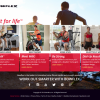I resisted contact lenses for years.
I knew as soon as I started high school that I needed them, but after a childhood of watching them irritate my father’s eyes, I didn’t want anything to do with contacts. I held off as long as I could – all through high school, all through college, and after – but finally succumbed to corrected vision earlier this year.
It was one of the best decisions I have ever made. So much has changed since the contacts my father wore. They’re now healthier for your eyes, more comfortable to wear, and easier to care for than ever before.
Contact lenses have been around since the late 1800s, but it was the introduction of soft contacts in the 1970s that ushered in the modern era of corrective lenses. Earlier this year contacts evolved again, thanks to the work of scientists at Ohio State University’s School of Optometry. The Ohio State team created one-day contact lenses composed of 78% water, the same amount of water found in the eye’s cornea. The advancements of the one-day lenses allow for a steady stream of oxygen to reach the eye, making them more comfortable and healthier for the wearer.
Disposable lenses aren’t the only game-changing development in the world of corrective lenses. Bifocal and multifocal lenses are becoming popular with the 40-60 age group who desire the functionality of bi- and multifocal glasses without the hassle of wearing glasses. They’re an especially useful improvement for active adults who can’t wear glasses during athletic activities.
The latest technological advancement in contact lenses is custom-made silicone hydrogel lenses. Silicone hydrogel contact lenses maintain eye health and vision by supporting the cornea’s need for oxygen. The lenses have a lower water content than most soft lenses, making them a wise choice for those who experience dryness with standard soft contacts.
What does the future have in store for contact lenses?
If Google has anything to say about it, it could be augmented reality. Google introduced the Google Glasses earlier this year, a mind-blowingly cool project that would allow your glasses to perform many of the same tasks as your smartphone.
Need to schedule a meeting? The Glasses have got it covered. Want to capture what you’re seeing in a photo? The Glasses will snap the shot. Curious about tomorrow’s weather? The Glasses will bring up the report for you. Lost? The Glasses will give you directions.
So far Google has only announced the Glasses, but a company called Innovega is working on the iOptik lens, an innovation that is set to bring an augmented, superimposed 3-D virtual reality to contact lenses.
Where do I sign up?
For a great supplier of contacts you should read our 1-800 Contacts review.












